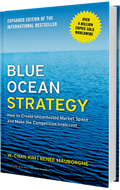Blue Ocean Strategy for your daily business
I’m sure you’ve heard of “getting the best of both worlds”; of receiving two of your favourite, most-wanted things in a single, neat little package. After all, it’s a common saying for a reason. Consumers love the two-for-one deal, the all-in-one service, the added value of finding everything they need in one place. And yet, when most of us think of successful businesses, we don’t think of businesses that operate on the edge of two worlds, but are firmly and aggressively grounded in one.
Being successful then, is about beating the competition in that space by delivering whatever product or service they’re offering to the exact same customers and, ultimately, competing for the same market share. It’s about delivering one thing and one thing only, just better or cheaper than the competition.
1. Missing business opportunities
2. Red Ocean vs Blue Ocean
3. Main points of strategy
4. The Party Booster
5. The story of [yellow tail]
6. Conclusion
Missing business opportunities
But what if single-mindedly focusing on your niche and immediate competition could put you in a situation where you’re always fighting to offer your products or services at the cheapest price or with as much content (e.g. features, style, quantity) per euro as possible? Maybe you already feel like you have to continuously cut your margins or regularly add on new features and offers; only to find that your competitors decide to do the same and you need to start over?
This kind of near-constant, cut-throat competition could create a very unhealthy dynamic, which would significantly reduce the capital you need to innovate your print business and prevent you from developing a deeper understanding of both your real value as a business and of your customers. Moreover, and perhaps worst of all, it may cause you to miss out on large swathes of customers altogether.
This risky situation resulting from pursuing either low cost or differentiation in the same market(s) is the core idea developed in Blue Ocean Strategy, a book (and business philosophy) written by W. Chan Kim and Renee Mauborgne. As they explain it, the Blue Ocean strategy is about “the simultaneous pursuit of differentiation and low cost to open up a new market space and create new demand”. It essentially boils down to this: to be successful, you don’t actually need a revolutionary product or service.
Instead of trying to outprice or outsmart your competition, you need to reconceptualize your offer into a new value proposition, “creating and capturing uncontested market spaces” where “the competition is irrelevant”, as W. Chan Kim and Renee Mauborgne put it.
Red Ocean vs Blue Ocean
According to Kim and Mauborgne, ‘red oceans’ are all the market spaces that currently exist – the ones you’re probably working in. They use red to indicate how businesses in these environments ‘bleed’ due to being constantly attacked by the competition. In a ‘blue ocean’, you are in a market of your own because blue oceans are made up of industries that will only come into existence when they manage to create (and fulfil) a new demand. Carefully consider the term ‘demand’ here. Blue oceans are not necessarily defined by a new product or service, but by answering to a different need.
In a blue ocean environment, market boundaries and industry structures are not yet set. As entrepreneurs are creating these spaces, it’s up to them to rebuild these by creating and answering to new, inexistent demands and, as a result, set the rules to a completely new game. In a red ocean, your margins are low and you are forced to engage in continuous competition over prices or differentiation rather than value, resulting in a cut-throat, low-innovation business environment.
By contrast, blue oceans are high-innovation environments offering products and services of truly unique value to new market spaces, developed through and driven by a mix of innovation and experimentation. Price competition doesn’t really exist here because no one else is offering exactly what you’re offering to these new audiences, resulting in much higher profits.
But it’s important to remember that this isn’t about inventing a completely new product or about developing a wonderful idea with the sole purpose of beating the competition. Rather, it’s about offering something different by using and rethinking what you already have.
Think of the way Apple shifted the focus from raw computing power to smart design, user experience and, ultimately, symbolic status. Computers were not new, but Apple focused on something Microsoft couldn’t - and in many ways still doesn’t - compete with. To effectively get to this point, however, you need to look at your business with different eyes, find out how your particular expertise can be channelled to appeal to new target audiences.
If you do that right, your audience will likely expand or shift to include not just the customers you’re already targeting today, but customers you might have never really thought of at all, by proposing effective, previously inexistent, solutions to new and unanswered problems.

So, in the midst of these unusual times, we invite you to take a step back with us, and consider how this strategy could benefit you and your business in the long run, once things have returned to normal. Let’s start by having a look at the core strategy.
Main points of the strategy
The blue ocean strategy is composed of many different strategic steps, but in essence, this is what you should try to focus on:
- Analyse how your products and services can be offered in different and new ways by targeting them at a very specific problem or demand that no one is really focusing on. This will help you create new business spaces and define new relevant markets.
- Move from focusing on your competition to offering real and practical value to new consumers, and consider how this new value proposition can be scaled to other potential customers as well.
- Don’t choose between differentiation or low cost, but strategically focus on both.
In their book, Kim and Mauborgne outline many different tactical approaches, but perhaps one of the most useful and practical ones is what they call the ERRC framework: Eliminate. Raise. Reduce. Create.
Eliminate |
Raise |
| Eliminate elements that are the main drivers of competition in your current market to help you navigate out of the red ocean environment. | Raise elements typical of your market to a higher standard to differentiate your offer and make it more valuable to customers. |
Reduce |
Create |
| Reduce elements typical of your market that are not bringing about added value or sufficient differentiation to reduce cost. | Create elements that your current market doesn’t offer to appeal to a wider audience and reach new customers with different needs. |
To maximize cost as well as differentiation simultaneously, it’s important to focus on “eliminating and reducing, as well as raising and creating”. While many businesses might instinctually think of the blue ocean strategy as being about creating and raising new business opportunities, it’s equally as important to know which industry factors aren’t needed, either as much or at all. Let’s make use of an imaginary example to make this rather theoretical idea a little more concrete.

The Party Booster
Let’s use an example to contextualise the above, to show how these ideas can be utilised when the crisis is over. Let’s imagine that you’re a print service provider in an urban area home to a wide range of renowned event locations, busy bars, pubs, youth and charity organizations, and various festivals.
You’ve been in print for many years, built a website categorizing your work into the various accepted sections (flyers, posters, stickers, labels, signs, …) and your advertisements all use common industry jargon (speed, colour accuracy, high-quality finishes, ….). As it stands, your business is competing with every other print service provider in the area for the same print jobs, using mostly the same strategies.
One day, you realize that your company’s finest work is the work you do for events, festivals and organizations in the area. And that you not only enjoy working with these people, but genuinely love the challenge of delivering eye-catching prints that drive footfall. You know the field, and you know what they need. But you’re also stuck doing your usual work where the main concern is price, and your margins are suffering greatly.
Now, the blue ocean strategy would suggest that by focusing strictly on print work, and not on delivering a unique value proposition, you’ve put yourself at the mercy of that market. You’re under constant time pressure, trying to deliver your work as quickly and cheaply as humanly possible to just about anyone, while still constantly being undercut by the competition.
Right now, your business is in a red ocean.
Realizing that you need a change, you decide to flank your current business strategy by creating a one-stop print shop for events, parties and festivals. You want to bundle your passion and expertise into a business that offers them the complete advertising package: all the print materials they need, fast delivery, expert advice, installation and exceptional service. Your ERRC strategy could look something like this:
1. What to eliminate?
You eliminate standard print jargon from your offer and start speaking of festivals, events, and parties instead. You use your time to fully focus on the particular needs and problems of the businesses and people you’re trying to reach.
2. What to reduce?
You decide to reduce the overall complexity of choice on your website and print catalogue. Before, your customers would have had to look through massive amounts of categories and subcategories just to find the materials they were looking for. Now, your offer is more modular, better organized, and based on the terms and categories your customers would actually use.
3. What to raise?
You make it easier to get in touch with you and to understand what it is you’re offering. You’ve started proposing graphic outputs that are specific to events, festivals and parties, by building your offering around completely new categories such as ‘fund raiser essentials’, ‘club night’ and ‘festival packages’ that include everything such customers need to organize a successful event (posters, banners, floor graphics, scarves, trinkets, invitations, etc.).
You’ve made your website easier to navigate (or even created a completely new one for this particular business), allowing customers to easily select the materials they want to include in their order.
You study your audience, the way they talk, what they read, where they go to find information. You put up a local campaign on social media and use targeted Google ads to make sure you’re quickly and easily found by people showing interest in your offering. You won’t market yourself as a print provider but as party booster. That’s significantly different, isn’t it?
4. What to create?
You’re working on an ad-hoc phone line and a new advertising campaign for your local radio. You’ve also created design templates to choose from on your web platform. And you’re thinking of including a delivery service like Deliveroo. You’re even talking to 3rd party companies who could help with the immediate installation of large banners and other advertising materials.
This may seem like a trivial example, but it should help to make the strategy a little more concrete. While neither ‘events’ nor ‘print materials’ are in any way new, combining them in this way and realigning your business strategy around them, could help you tap into completely different markets without having to compete with all the other print service providers. And for your customers, a business like that really does give them the best of both worlds: a partner who doesn’t just deliver outstanding print work, but also truly understands the needs and challenges they face. Someone who really speaks their language.
And over time, it may help you expand your customer base to include not just the pubs and organizations themselves, but schools, sports teams and event agencies who may have never otherwise known about your specific expertise. To show you just how effective such realignment strategies can be, let’s look at a real-world example from the book.
The story of [yellow tail]
To give you a better idea of the concept, let’s have a look at the [yellow tail] case. In 2001, the Australian-based wine company Casella Winery was looking to launch a new wine label. But at the time – and arguably still today – the traditional wine business was split up into two highly competitive markets: cheap, mass-produced wines and prestigious, expensive wines. This made it incredibly difficult for any new wine brand to stand out from the crowd.
Your marketing choices were mostly limited to either offering more (taste, rarity, prestige, price, grape quality, etc.) or less. These two existing markets are classic examples of red oceans. Breaking through in either would’ve meant fierce competition and a very slim chance at success. And also, the channels to reach such audiences are quite expensive: premium magazines, TV, wine tasting events. But Casella didn’t want to compete with either of them by creating another run-of-the-mill wine.
See, the thing about wine is that, while cheap wine often tastes pretty awful, expensive wine can be a bit of an acquired taste. Like with whiskey, most people have to slowly work their way up to the more unique and expensive bottles. Casella wanted to change that with a wine that was actually fun and easy to drink. A simple wine for people to enjoy, even non-wine experts that would usually drink sodas or drinks, without having to crack open a prestigious bottle or know anything about wine at all (raise your hand if you’ve ever felt embarrassed about having to choose a wine a-la-carte or, worse, taste it in front of the whole table!).
And so they made [yellow tail]: a sweet wine with a pleasant taste, easy to choose, sold in a fun and colourful packaging. Basically, the wine version of beer.Did it work? Well, despite being an unknown brand in a highly competitive market, it didn’t just sell the expected 25,000 cases in its first year, but close to 225,000. And only four years and a whopping 25 million cases later, [yellow tail] became the best-selling 750ml red wine bottle in the US, beating other, better-known American, French and Italian wine brands. So the answer is: yes, it did.
Conclusion
By ignoring the accepted strategies and established markets for their product, Casella Winery created a real blue ocean. Instead of primarily focusing on how to beat the competition, Casella worked on studying the needs, attitudes, pains and ambitions of a completely new target audience, never touched before by any of the cheap/expensive wine competitors. They developed a fundamental understanding of the product they wanted to make, the customers they wanted to reach, and the ways in which they could reach that audience.
Because Casella disregarded the rules and played entirely by its own, it was able to draw in a whole range of customers neither of the other two players were ever able to reach at all. And that mindset is crucial for finding your space in the blue ocean. Sure, it may seem daunting at first, but there’s ample evidence to suggest that it works. And all it takes is a little bit of imagination, careful analysis and strategic planning. Stop focusing on what your competition is or isn’t doing and targeting all the same customers with lower prices or brighter colours, and start leveraging your particular strengths and talents to create a business that’s truly unique.
Look around at the many business possibilities that aren’t really served by anyone today, by for example checking the outliers in your database. This will allow you to combine low cost and differentiation to much greater effect, and your own rules.



